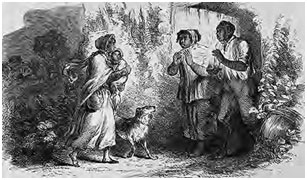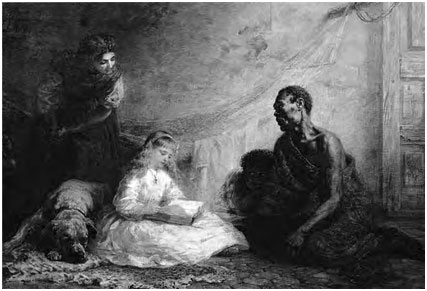Lincoln Idealist and Pragmatist - Appendix VIII - Unclie Tom's Cabiin
Uncle Tom’s Cabin
by Harriet Beecher Stowe
Uncle Tom’s cabin is a story written during the days of slavery in the U.S. that illustrates the trials and tribulations of life as a slave in America. It focuses on the life of two slaves, Tom and 4-year-old Harry, who have been sold due to financial difficulties by their kind owner, a Kentucky farmer Shelby to Haley, a ruthless slave trader. While Eliza, mother of little Harry decides to run away with her son, Tom decides to go with Haley to be sold at a slave market. This story focuses on their respective journeys fraught with limitless dangers, physical challenges and emotional pain. It elucidates Eliza’s perils as she is hounded by Loker, a slave hunter, her miraculous crossing over a semi-frozen river to the North, which is relatively safer, her reuniting with her husband who too is a fugitive slave aspiring for freedom, and ultimately their escape to Canada with the assistance of Quakers. It tells the story of Uncle Tom, as his previous owner’s son George fondly called him; of his pain at being separated from his wife and children and his experiences as he saves Eva, the angelic little girl from drowning, and benevolent St. Clare, her father who buys him from Haley out of gratitude and takes him to their home in New Orleans. It recounts Uncle Tom’s growing friendship with Eva and their daily talks about

Eliza comes to tell Uncle Tom that he is sold and that she is running away to save her child
their Christian faith. It is a story of his endless misery and adverse luck; the death of Eva and her father, after which he is sold off to his vicious new owner Legree, Uncle Tom’s unflinching faith in God despite relentless physical torment, ultimately of his death as he is savagely beaten for encouraging two female slaves to flee and the futility of the late arrival of his Master George who comes to buy him back. But it ends on a happy note; the other slaves either flee to safety or are emancipated.
It is not a tale of cruelty and suffering alone; it is also about hope and promise; it is about determination and courage. The Quakers, Eva and St. Clare are benevolent forces, that come into their lives to soothe their journey through the pain and torture that they have to endure. It elucidates how St. Clare, with kindness and patience restored love and faith in Topsy, a slave girl, embittered by her painful life in servility. This story also illustrates the presence of faith and compassion that can transform and cleanse the most savage human heart of its hate and prejudice as the change that Eliza could bring about in Loker; despite his remorseless pursuit of her, she does not leave him to die after she shoots him; she treats his gunshot wound and nurses him till he is healthy again.
This novel was written by Harriet Beecher Stowe (1811-
1896), an author and social activist and published in 1851 as a series and later as a complete novel in 1852 as a reaction to the Fugitive Slave Law. A daughter of a preacher and sister of an abolitionist, she was raised in an atmosphere that supported social justice, women’s rights and the liberation of slaves.
The Fugitive Slave Law of 1850 made it mandatory for every citizen to aid and assist in catching runaway slaves. Bribery was rampant through which the commissioners facilitated the restoration of slaves to their owners. Harriet was livid. She felt it was immoral for the government to demand the complicity of ordinary citizens to aid in catching runaway slaves. She rebelled against the system and began harbouring runaway slaves in her home; to prevent her maid from being caught and returned to her owner, she helped her escape to Canada and gain legal freedom. But this was not enough to douse her anger towards the system of slavery prevalent in the country; she then decided to use her pen to fight against the system of slavery.
While she was living in Cincinnati, which was a hub for the underground railway1, she met with many fugitive slaves on their way to freedom. She had first hand information from her black cook and other servants who had been prior slaves about their painful experiences. She also received authentic information from Frederick Douglass and others about the realities of the Deep South where slavery was prevalent in its most ugly form. Josiah Henson, a fugitive slave who escaped to Canada, founded a settlement and opened a school for other fugitive slaves was the inspiration behind one of the characters in her novel, George Harris, Eliza’s husband.
Stowe actively supported social and political causes throughout her life and wrote novels, essays and textbooks till her death in 1896. Stowe’s novel made Northerners become conscious of not only the brutality that slaves were tolerating but also the beast that it brought out in their white masters. It fanned the flames
_____________________
- Though not really a railroad, it was a name used for a network of people, homes, and hideouts in the North that helped fugitive slaves as they fled from their southern owners enroute to Canada.

of the divide between pro and anti slavery factions in America;
- while it stimulated the abolitionist movement in the North it was met with anger and disapproval in the south. It sold 300,000 copies by the end of 1852 and became the second best selling book after the bible. It sold more in England than the U.S. and was greatly influential in moulding public opinion that finally pushed the Government of England a decade later to withdraw support to the south despite the mutually beneficial economic trade relationship. When Lincoln issued the Emancipation Proclamation in 1863, Stowe danced in the streets with joy.
Related Books
- Alexander the Great
- Arguments for The Existence of God
- But it is done
- Catherine The Great
- Danton
- Episodes from Raghuvamsham of Kalidasa
- Gods and The World
- Homer and The Iliad - Sri Aurobindo and Ilion
- Indian Institute of Teacher Education
- Joan of Arc
- Lenin
- Leonardo Da Vinci
- Lincoln Idealist and Pragmatist
- Marie Sklodowska Curie
- Mystery and Excellence on The Human Body
- Nachiketas
- Nala and Damayanti
- Napoleon
- Parvati's Tapasya
- Science and Spirituality
- Socrates
- Sri Krishna in Brindavan
- Sri Rama
- Svapnavasavadattam
- Taittiriya Upanishad
- The Aim of Life
- The Crucifixion
- The Good Teacher and The Good Pupil
- The Power of Love
- The Siege of Troy
- Uniting Men - Jean Monnet